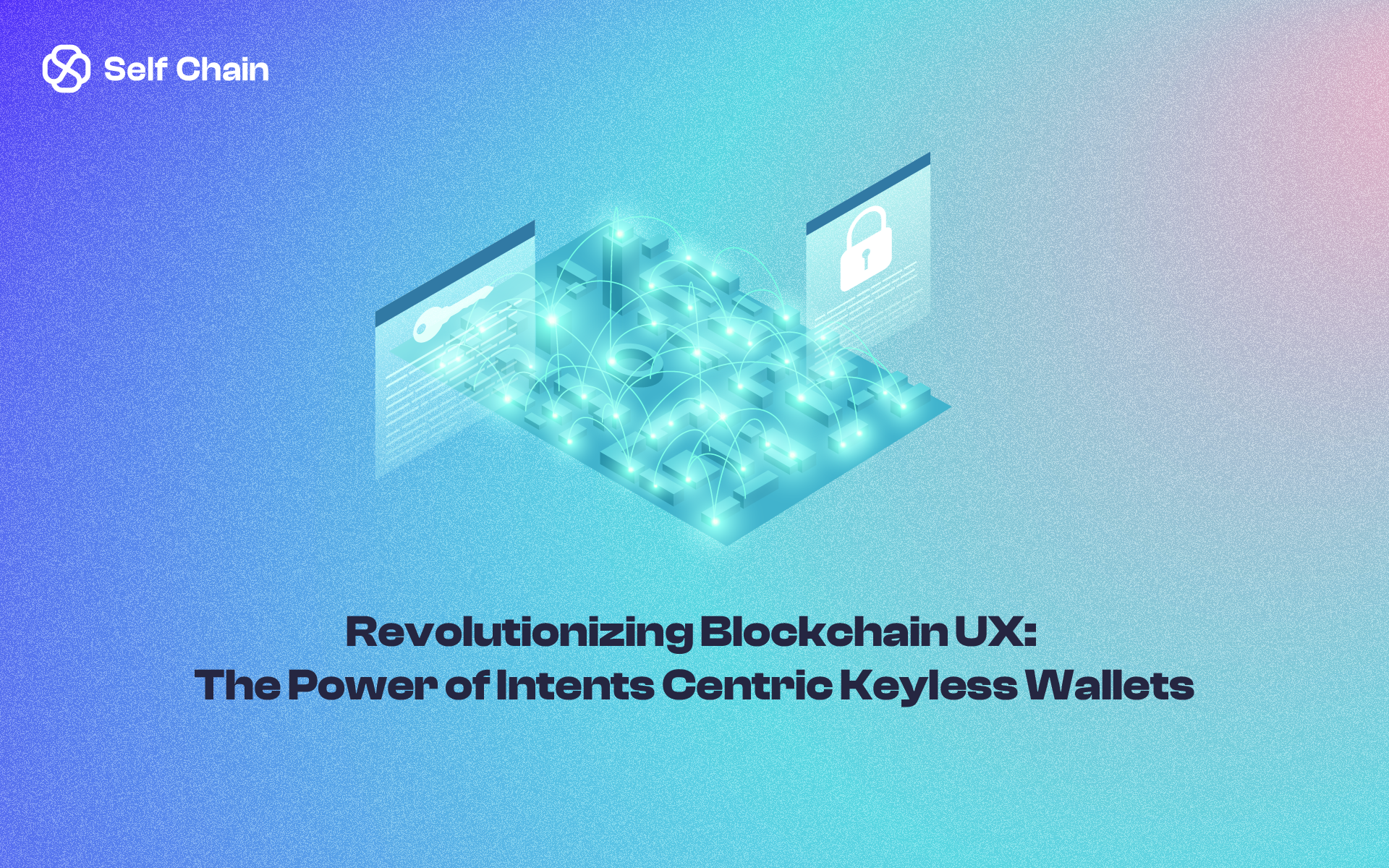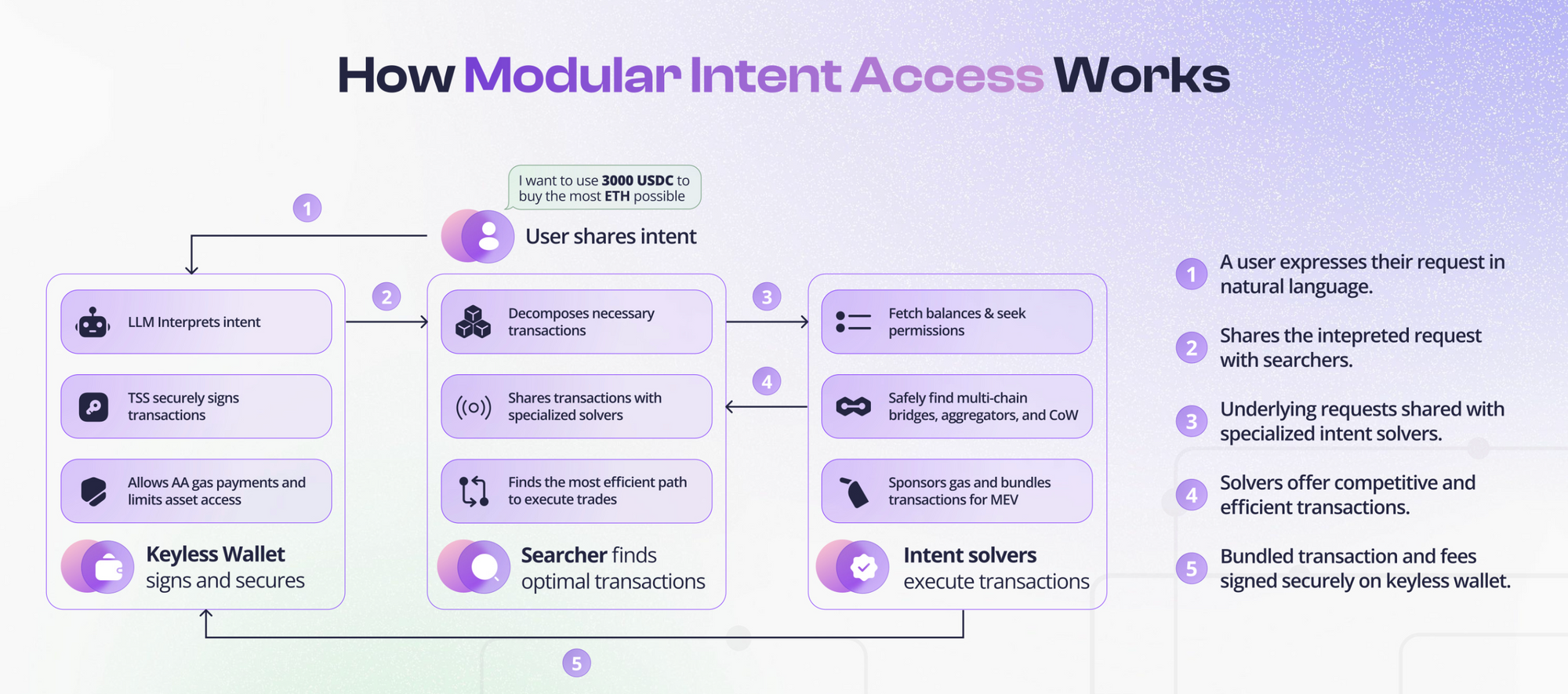Revolutionizing Blockchain UX: The Power of Intents-Centric Keyless Wallets
Unlocking simpler blockchain interactions with Self Chain's intent-focused, keyless solutions.

The blockchain industry has come a long way, but one aspect that still presents a challenge for users is the uninviting user experience (UX) associated with externally owned accounts (EOAs) and traditional blockchain transactions. Imagine a scenario where a user, eager to explore the world of dApps or initiate a blockchain transaction, is confronted with the daunting task of managing cryptographic keys, complex wallet setups, and the constant fear of making an irreversible mistake.
For instance, users take on the responsibility of securely storing their private keys or seed phrases, often resorting to traditional methods like writing them down on a piece of paper, which is susceptible to loss or theft. Additionally, understanding the intricate world of gas fees, smart contract interactions, and wallet compatibility can feel like exploring a maze, especially for newcomers.
What if I told you we found the solution: Intents? In this article, we'll delve into the world of Intents, explore their role in improving the UX in Web3, and discuss the groundbreaking concept of Keyless Wallets level solutions, which promise to revolutionize how we interact with blockchain technology.
Introducing Intents
Imagine blockchain transactions without the complexity of navigating external accounts and transaction details. This is precisely where Intents come into play. At its core, an Intent allows users to express their desired outcome while delegating the task of determining the best way to achieve that outcome to sophisticated third parties. Instead of micromanaging every step, users set their goals and constraints, granting permission for others to take care of the rest.
The UX Revolution with Intents
The primary goal of Intents is to revolutionize the UX in Web3. By shifting the focus from complicated transaction details to desired outcomes, Intents promises smoother, more user-centric interactions with blockchain technology. Users no longer need to grapple with the intricacies of EOAs and transaction parameters; they simply express their intentions, and the system takes care of the rest.
The concept of intent isn't just theoretical; it's already making waves in the blockchain ecosystem. Existing projects, such as Cow Swap, 1inch Fusion, UniswapX, Account Abstraction (AA), Essential, Flashbots SUAVE, and Anoma, are adopting intents in various ways to enhance user experiences and optimize blockchain transactions.
Here's a summary of how these projects are integrating intents:
- Cow Swap & 1inch Fusion (Limit Order Intent):
- What They Do: Cow Swap and 1inch Fusion are decentralized platforms where users can express their intentions to trade or set specific limit orders on blockchain assets.
- How It Works: Users interact with these platforms to express what they want to do, and they can even set conditions for their trades. Solvers on these platforms help find the best way to execute these trades efficiently.
- Benefits: Users get more control over their trades, and the platforms aim to get them the best prices by using solvers to optimize the trading process.
- UniswapX (Swap Intents):
- What They Do: UniswapX introduces a mechanism for users to express their trading intentions with more freedom, allowing them to specify different parameters for their trades.
- How It Works: Users can set up "Dutch auctions" for their trades, which means they can specify starting prices and how prices change over time. Solvers compete to fulfill these auctions efficiently.
- Benefits: This flexibility can lead to better trade execution and potentially better prices for users, while solvers aim to get the most profitable trades.
- Account Abstraction (AA) (Wallet-Level Intent):
- What They Do: Account Abstraction enables users to express their intentions directly through their wallets. They can authorize specific actions and let bundler services handle the rest.
- How It Works: Wallet owners create intentions through their wallet interfaces, and bundler services handle the technicalities. These bundlers are often open-source and considered public goods.
- Benefits: This approach simplifies blockchain interactions for users, as they only need to interact with their wallets. Bundlers optimize transactions, making them more cost-effective.
- Essential (Intent-Centric Account Abstraction Standard):
- What They Do: Essential is working on an intent-centric standard that makes expressing intentions on blockchains easier and more modular.
- How It Works: DApps and wallets using Essential can offer intent-enabled services. Users express their intent using this standard, simplifying their interactions with blockchain applications.
- Benefits: Essential aims to streamline blockchain interactions and allow various types of solvers to join, improving the overall user experience.
- Flashbots SUAVE (Multi-Domain Block-Related Intent):
- What They Do: SUAVE introduces a dedicated chain for settlement purposes, offering a unique approach to expressing intents on the blockchain.
- How It Works: Users express intents through EVM code, and solvers, such as searchers and builders, work together to fulfill these intents efficiently.
- Benefits: SUAVE's multi-chain capability and privacy features aim to make blockchain transactions more cost-efficient and secure while enabling various domains to capture value from MEV.
- Anoma (Generalized Intent for Anoma Protocols):
- What They Do: Anoma is a general architecture for blockchain protocols that emphasizes intent-centric design.
- How It Works: Users interact with Anoma DApps to express their intents. Solvers, specializing in different applications, monitor these intents and find ways to fulfill them.
- Benefits: Anoma's approach aims to make blockchain interactions more efficient and versatile, allowing users to specify what they want to achieve more precisely.
These projects are all focused on enhancing the user experience in the blockchain space by allowing users to express their intentions clearly and efficiently, often with the help of solvers or automated processes.
The Role of Third-Party Solvers
Third-party solvers are the backbone of the Intent-centric architecture, serving as indispensable guides to users' intentions in the blockchain world. Their core role is to transform user-friendly intents into streamlined blockchain actions, making the technology accessible and efficient for all.
Key Functions of Solvers:
- Intent Translation: Solvers decipher user intents, breaking them down into actionable steps within the blockchain environment. This translation process simplifies user interaction.
- Efficiency Experts: Solvers specialize in executing intents efficiently. They consider various factors such as better returns, gas fees, and liquidity, optimizing transactions for speed, cost, and user preferences.
- Technical Wizards: Handling the intricacies of blockchain, solvers navigate cryptographic operations, smart contracts, and even cross-chain transactions effortlessly.
- User-Centric Focus: Solvers prioritize user goals, ensuring that transactions align with user preferences, whether it's minimizing fees or maximizing returns.
Solvers play a pivotal role in the Intent-centric architecture, bridging the gap between users and blockchain technology. Their automation and expertise make blockchain accessible to a wider audience, simplifying decentralized finance and applications.
Effortless On-chain experience with MPC Keyless Wallets
To make Intent-centric applications even more user-friendly, Keyless Wallets are introduced. These wallets are designed with the intent-based approach in mind, making it possible for automatic workflow execution and acting as the first gateway before solvers pick up the user's intents. Keyless Wallets simplify the initial interaction, making it effortless for users to express their desires.

One of the critical elements of Intent-centric applications is ensuring secure and effortless on-chain confirmation between wallet interfaces and solvers. This security is achieved through MPC-TSS, which safeguards users' data and intentions. With MPC-TSS, Self Chain powered wallet-level intents become a reality, offering a seamless experience for all users.
Integrating Intents into MPC Wallets:
- Intent Definition: First, define the types of intents that users can express within the MPC wallet. These intents could include sending tokens, interacting with specific smart contracts, or executing complex DeFi operations.
- User Interface: Create a user-friendly interface within the MPC wallet where users can express their intents. This interface should allow users to specify what they want to do, such as transferring a specific amount of tokens to a particular address or participating in a liquidity pool.
- Intent Verification: Before executing any intent, the MPC wallet should verify the user's identity and intent. This verification process may involve biometrics, device authentication, or other security measures to ensure that the intent is legitimate and authorized by the wallet owner.
- Secure Intent Processing: Once the intent is verified, the MPC wallet can use its multi-party computation capabilities to securely process the intent. This involves creating cryptographic shares of the intent data and distributing them among the participating parties in the MPC network.
- Secure Signing: In cases where the intent involves cryptographic signatures (e.g., authorizing a transaction), the MPC wallet can securely generate the required signatures using the distributed shares. The private keys never need to be fully reconstructed in one place, enhancing security.
- Intent Execution: With the intent securely processed and signed, the MPC wallet can execute the desired action on the blockchain. For example, if the intent is to send tokens, the wallet can broadcast the signed transaction to the network.
- Confirmation and Feedback: After execution, the MPC wallet should provide confirmation to the user, indicating that their intent has been carried out. It's essential to maintain transparency and keep the user informed about the status of their actions.
Example: Swapping Tokens with an Intent-centric MPC Wallet
Let's say a user wants to use 3000 USDC to buy the most ETH possible using an Intent-centric MPC wallet:
- The Keyless wallet’s LLM interprets the user’s intent and shares it with searchers.
- The searchers find the most efficient path (for example the DEX with the best price, and the smallest slippage..) to execute the trades and share the transactions with specialized solvers.
- The Intent Solver fetches balances and seeks permissions.
- Secure transaction signing with TSS to grant permissions to Solver.
- Intent Solver safely finds the multi-chain bridges, aggregators, and CoW to execute the transactions.
- The wallet provides the confirmation for all transactions to the user, indicating that the intent to swap tokens has been successfully executed and the wallet balance is updated after the trades.
In this example, the MPC wallet combines user-friendly intent expression with strong automated execution ability enabled by Modular Intent-Centric Access Layer1 blockchain and MPC-TSS/AA architecture. This approach enhances both the user experience and the security of blockchain interactions.
Self Chain's Role in Revolutionizing Blockchain UX
Self Chain is the first Modular Intent-Centric Access Layer1 blockchain and keyless wallet infrastructure service using MPC-TSS/AA for multi-chain Web3 access. The innovative system simplifies the user experience with its intent-focused approach, using LLM to interpret user intent and discover the most efficient paths.
Self Chain ensures that onboarding and recovery are effortless with keyless wallets that grant users complete self-custody over their assets. In addition, it provides automated rewards to dApps when they efficiently resolve user intent, further enhancing the user experience. Moreover, Self Chain incorporates Account Abstraction with MPC-TSS to provide secure signing and reduce transaction fees. It's a platform that redefines blockchain interaction, making it more secure and user-friendly for everyone.
In a world where blockchain technology is becoming increasingly essential, the user experience remains a critical factor in its adoption. Intents and Keyless Wallets are set to transform the landscape, making blockchain interactions more accessible, efficient, and secure. As we move forward, the blockchain industry has the opportunity to provide users with a seamless and enjoyable experience, unlocking the full potential of this groundbreaking technology.
